Plains indigenous peoples
| Taiwanese indigenous peoples |
|---|
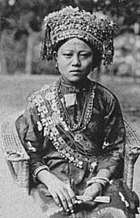 |
| Peoples |
|
Recognized Locally recognized Unrecognized |
Plains indigenous peoples (Chinese: 平埔族群; pinyin: píngpuzúqún; Pe̍h-ōe-jī: Pêⁿ-po͘-cho̍k), previously called plain aborigines, are Taiwanese indigenous peoples originally residing in low land regions, as opposed to Highland indigenous peoples. Plains indigenous peoples consist of eight individual peoples, rather than being a single ethnic group. It is part of the Austronesian family. Plains indigenous peoples have been labelled by Japanese and Han Chinese as "plains savages" or the term Pepohoan[1] (平埔番; Píngpǔfān; Pêⁿ-po͘-hoan)[2] from Hokkien and "cooked savages" (熟番; shúfān; se̍k-hoan).[3] Beginning from the 17th century, plains indigenous peoples have been heavily influenced by external forces from Dutch, Spanish and Han Chinese immigration to Taiwan. This ethnic group has since been extensively assimilated with Han Chinese language and culture; it has lost its cultural identity and it is almost impossible without careful inspection to distinguish plains indigenous peoples from Taiwanese Han people.
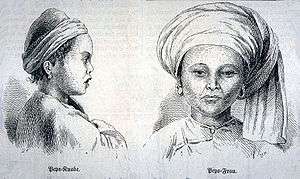
Plains indigenous peoples have not been officially recognised by the Taiwan government, apart from the Kavalan. It was not until the mid-1980s that plains indigenous peoples started gaining interest from historians and anthropologists, leading to increased public attention to this group. Various anthropological studies have emerged in recent years arguing that circa 85% of Hoklo and Hakka Taiwanese are actually descendants of plains indigenous peoples through intermarriages with Han immigrants. This is still an ongoing debate and has been used as political leverage to promote Taiwan independence and ethnic consciousness. An increasing number of Hoklo and Hakka are beginning to search for plains indigenous bloodlines in their genealogy, and many are starting to claim themselves as plains indigenous peoples. These indigenous groups are currently continuing to fight for its identity, rights and recognition as Taiwanese indigenous peoples. In 2016, the Tsai Ing-wen administration promised to grant official recognition to the plains indigenous peoples[4], and draft bill is being reviewed by the Legislative Yuan as of Jun 2018.[5][6]
Background
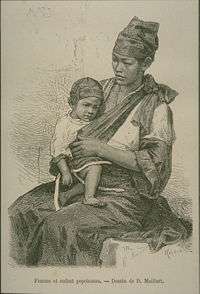
In The Island of Formosa (1903), former US Consul to Formosa James W. Davidson presented the first English-language account of the indigenous peoples of the whole island, which was almost entirely based on the comprehensive work collected over several years of study by Ino Kanori, the foremost authority on the topic at the time.[7] In Ino's eight-group classification, the Pepo, Puyuma, and Amis groups were known as "domesticated savages" (Japanese: 熟番 Hepburn: jukuban), primarily due to their abandonment of ancient customs. Of these three groups, only the Pepo lived in the western plains where they remained to compete with the Chinese settlers (the Puyuma and Amis inhabited the eastern plains).
The term Pepo (Chinese: 平埔; pinyin: píngpǔ; Pe̍h-ōe-jī: pêⁿ-po͘; literally: "flat plain"), referred to indigenous peoples that resided in the Formosan plains, rather than the highland mountainous regions. Plains indigenous peoples mainly settled in the west and central mountain regions of Taiwan.[8] The term Sek-hoan (熟番; shúfān; se̍k-hoan; "well-cooked/familiar savages") was also used to describe plains indigenous peoples because they often lived closer to the coast and had more interaction with Dutch and Han Chinese immigrants, hence were more assimilated and civilised than highland indigenous peoples. Mention of plains indigenous peoples have appeared in Qing texts dating back as early as 1764.[9] In summary, the Pepo were those plains indigenous peoples who could still be easily distinguished from the Chinese, whereas the Sek-hoan had already thoroughly adopted Chinese customs, thus exhibiting no trace of their "ancient life".[10]
In the 17th century, plains indigenous peoples were involved in the flourishing deerskin export market. Plains indigenous hunters often supplied deerskin to the Qing and Dutch regimes, in exchange for cash to trade for other goods and also to pay for taxes enforced under the new regimes.[11] By the 18th century, the deerskin industry had largely diminished due to overhunting, and the inflow of Chinese immigrants began to take up much of the grazing land.[12] Therefore, plains indigenous peoples increasingly relied on plow agriculture and land rent from indigenous land reclaimed by Han settlers.
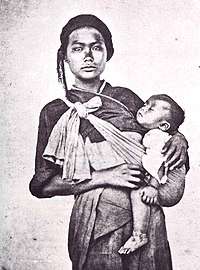
Han settlers initially implemented policies that favoured plains indigenous peoples. This was because Han officials feared a revolt against Chinese immigrants, and also because plains indigenous peoples were tax-paying citizens and could be used as military sources.[13] Furthermore, the Chinese government initially viewed their expansion as a disruption to the indigenous people status quo, hence they introduced policies to favour plains indigenous peoples. However, plains indigenous peoples were increasingly not able to compete economically and ethnically with the growing Chinese population that flooded to Taiwan. Han policies in favour of plains indigenous peoples began to disappear. Han settlers started to disintegrate many of the plains indigenous peoples from their original villages. It is within these “political and economic frameworks” that the plains indigenous peoples gradually became sinicized.[12]
Plains indigenous peoples began to adopt aspects of Chinese culture, values, and language. Most importantly, intermarriage between Chinese and plains indigenous peoples increased rapidly, leading to the acculturation of plains indigenous peoples with Chinese. Many of the early Chinese settlers in Taiwan were not permitted to bring women with them; hence they married plains indigenous women out of necessity.[8] This is the origin of the common saying “there are mainland grandfathers, but no mainland grandmothers” (Chinese: 有唐山公,無唐山媽; Pe̍h-ōe-jī: Ū Tn̂g-soaⁿ kong, bô Tn̂g-soaⁿ má).[14][15] This extensive intermarriage is the reason that many Taiwanese people today are unaware that they could be descendants of plains indigenous peoples. Several theories have been proposed during the 2000s, to suggest that a large majority of Hoklo and Hakka Taiwanese could have plains indigenous lineage in their bloodline.[16] An increasing number of Taiwanese are starting to search for their plains indigenous roots and claim their status as plains indigenous peoples.[17]
Plain Indigenous Peoples Recognition Movement
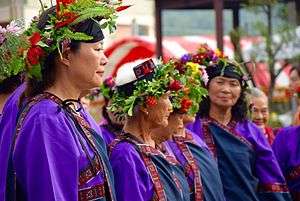
After centuries of acculturation, plains indigenous peoples are almost completely Hanised.[18] It was already noted in the early 20th century that careful observation was required to note their deeper eyes as compared to the Chinese; also, the women did not practice foot binding.[10] It is now nearly impossible to distinguish plains indigenous peoples without careful inspection.[19] Through the process of acculturation, much of the language, culture and identity of plains indigenous peoples have become non-existent in modern Taiwanese society.[18] The Republic of China government currently only officially recognises one (Kavalan) of all the plains indigenous peoples.[20]
Even though there was a lack of attention and interest in the history of plains indigenous peoples until the mid-1980s, through the works of scholars, folklorists, anthropologists, historians and remaining descendants of plains indigenous peoples, there have been a gradual restoration of plains indigenous culture, history, identity and language.[18] For example, a descendant of plains indigenous peoples in Hualien, Chieh Wan-lai, still insists on teaching the traditional language and culture of plains indigenous peoples.[19] More educational pamphlets are emerging to educate Taiwanese about the existence of plains indigenous peoples. Furthermore, a campaign was started in Yilan for descendants of the Kavalan to find their roots.[19] Many plains indigenous ceremonies have been revitalized around Taiwan, and these have been opened up to the public and to people who have recently discovered their status as plains indigenous peoples.[21]
Ethno-political activities and Nativist Cultural Movements flourished after the 1990s, and a “Plains Aborigine Name Correction Movement” (Plains Indigenous Peoples Recognition Movement) emerged.[19] Several protests occurred in 2001 and 2010, and a formal complaint was sent to the United Nations in 2010, demanding the ROC government to formally recognise plains indigenous peoples.[22] Descendants of plains indigenous peoples today continue to fight for the official recognition of their status as Taiwanese indigenous peoples.
Through the efforts of the indigenous people, Tainan County became the first local government to recognize Siraya people as county-level indigenous people in 2005, followed by the recognition of local Taivoan, Makatao, and Siraya people by Fuli Township Government in 2013. In 2016, Pingtung County Government announced the recognition of local Makatao. The Plain indigenous peoples have been allowed to registered in Kaohsiung City since 2013 but not yet been recognized as city-level indigenous peoples. The numbers of people who have successfully registered, including Kaohsiung City Government that has opened to register but not yet recognized, as of 2017 are[23][24][25][26]:
| Siraya | Taivoan | Makatao | Not Specific | Total | |
|---|---|---|---|---|---|
| Tainan | 11,830 | - | - | - | 11,830 |
| Kaohsiung | 107 | 129 | - | 237 | 473 |
| Pingtung | - | - | 1,803 | 205 | 2,008 |
| Fuli, Hualian | - | - | - | 100 | 100 |
| Total | 11,937 | 129 | 1,803 | 542 | 14,411 |
Classification
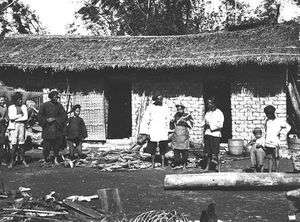
Plains indigenous peoples have been classified under different systems throughout history. The Dutch separated plains indigenous peoples by regions and differentiated them by communities (社名). Huang Shujing, during Qing rule, categorised all Taiwanese indigenous peoples into thirteen peoples, based on geographic location.[9]
It was not until the Japanese rule that proper anthropological and ethnographic classification systems of plains indigenous peoples were formed. The Japanese studies revealed that plains indigenous peoples were not one culture, but in fact consisted of various peoples, languages and cultures. The Japanese extensively studied Taiwanese indigenous peoples in order to classify, locate and civilise them.
Ethnographer Ino Kanori first to create the modern ethnological classification of plains indigenous peoples, consisting of the following peoples: Makattao, Siraya, Loa, Poavasa, Arikun, Vupuran, Pazehhe, and Kuvarawan.[27] Since then, other scholars such as Shigeru Tsuchida, Utsurikawa Nenozo, Mabuchi Toichi and Ogawa Naoyoshi have presented various classification systems for plains indigenous peoples.[9] There is still no full consensus over whether there are eight, nine, ten or twelves peoples of plains indigenous peoples. The major disputes consist of:
- Whether Arikun and Lloa should be classified separately or as one ethnic group.
- Whether Ketagalan should be further divided into separate groups.
- Whether Siraya, Taivoan, and Makattao are separate groups or part of one group. However, based on the latest discovery in linguistics[28][29], the three ethnic groups should be separate indigenous peoples.
- Whether Sao is a plains indigenous or highland people.
| Year | Researcher | Name | ||||||||||||||||
|---|---|---|---|---|---|---|---|---|---|---|---|---|---|---|---|---|---|---|
| 1904 | Ino, Kanori | Kavarawan | - | Ketagalan | Taokas | Vupuran | Poavosa | Arikun | Lloa | Pazzehe | - | Makattao | Sirajya | |||||
| 1930 | Utsurikawa, Nenozo | Kavarawan | - | Ketagalan | Taokas | Vupuran | Babuza | Hoanya | Pazeh | Sao | Tao | Sirajya | ||||||
| 1935 | Ogawa, Naoyoshi | Kavarawan | - | Ketagalan | Taokas | Vupuran | Babuza | Hoanya | Pazzehe | Sao | Sirajya | |||||||
| 1944 | Ogawa, Naoyoshi | Kavarawan | - | Luilang | Ketagalan | Taokas | Papora | Babuza | Hoanya | Pazeh | Sao | Sirajya | ||||||
| 1951 | 張耀錡 | Kavalan | - | Ketagalan | Taokas | Papora | Babuza | Hoanya | Pazeh | - | Siraya | Taivoan | ||||||
| 1955 | 李亦園 | Kavalan | - | Luilang | Ketagalan | Taokas | Papora | Babuza | Hoanya | Pazeh | Thao | Siraya | ||||||
| 1970 | 台灣省通志 | Kavalan | - | Ketagalan | Taokas | Papora | Babuza | Hoanya | Pazeh | - | Siraya | |||||||
| Arikun | Lloa | Makatao | Siraya | Taivoan | ||||||||||||||
| 1985-1991 | Tsuchida, Shigeru | Kavalan | - | Ketagalan | Basay | Kulon | Taokas | Papora | Babuza | Hoanya | Pazzahe | - | Makatao | Siraya | Taivoan | |||
| 1991 | Li, Paul Jen-kuei | Kavalan | - | Ketagalan | Babuza | Hoanya | Pazeh | Thao | Siraya | |||||||||
| Luilang | Trobian | Basay | Taokas | Papora | Babuza | Favorlang | Makatao | Siraya | Taivoan | |||||||||
| 1996 | Li, Paul Jen-kuei | Kavalan | Qauqaut | Ketagalan | Kulon | Baburan | Hoanya | Pazeh | Thao | Siraya | ||||||||
| Luilang | Trobian | Basay | Taokas | Papora | Babuza | Favorlang | Makatao | Siraya | Taivoan | |||||||||
| 2006 | Li, Paul Jen-kuei | Kavalan | - | Basay (Ketagalan) | Kulon | Taokas | Papora | Babuza | Hoanya | Pazih | Thao | Makatao | Siraya | Taivoan | ||||
Main Peoples
| Peoples | Early Settlement Locations |
|---|---|
| 1. Ketagalan | New Taipei, Keelung and Taoyuan |
| 2. Kavalan | Lanyang Plain |
| 3. Kulon | Taiyuan and partial New Taipei City. |
| 4. Taokas | Hsinchu, Miaoli and the northern region of Tachia River in Taichung |
| 5. Pazeh | Fengyan, Tantzu, Shenkang and Houli and later spread into Shihkang, Tungshih and Hsinshe |
| 6. Papora | Coastal plains to the south of Tachia River in Taichung |
| 7. Babuza | Southern region of Tatu River and the northern region of Choshui River |
| 8. Hoanya | Southern region of Wufeng in Taichung and the northern region of Wufeng in Taichung and the northern region of Hsinying in Tainan |
| 9. Siraya | Tainan & Kaohsiung |
| 10. Taivoan | Tainan & Kaohsiung |
| 11. Makatao | Kaohsiung & Pingtung |
Culture
Hunting, fishing and agriculture
Before the arrival of immigrants, plains indigenous peoples lived a simple lifestyle based on agriculture, fishing and hunting.[9] They produced just enough for their needs. Taros and yams were important in their diets. They used simple tools such as sticks and spades for growing food; to hunt they used traps, spears and arrows; to fish they used nets, baskets and arrows.[33] Men were usually in charge of fishing and hunting, while women were responsible for farming roles.[9] Deer and wild boars were the main hunting targets for plains indigenous peoples.
Matriarchal society
Plains indigenous peoples were based around a matriarchal society; women were often the head of the family and in charge of important household affairs.[34] Men usually lived with their wives after marriages, serving for their wives’ family. Females inherited property and passed on lineage. Women were usually in charge of religious issues and men were responsible for political issues.
Tribal systems
Although women had higher status in the clan system, in the tribal system men were superior.[34] Tribes were treated as a singular, collective unit. Leaders of the tribes were chosen based on seniority; the oldest member of the tribe became the leader. The elders were responsible for attending community meetings, at which a community chief was chosen to lead the community. The elders were also responsible for solving internal and external disputes.
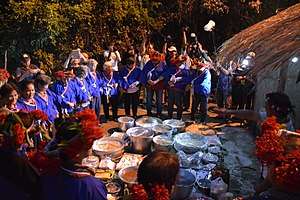
Ritual ceremonies
Plains indigenous peoples held ritual ceremonies several times a year, to worship natural and ancestral spirits. Plains indigenous peoples strongly believed in the worshiping of ancestors.[9] Whenever a ceremony was held, plains indigenous peoples would gather in the political centre of the tribe called “kunghsieh”, and they would drink, sing, dance and celebrate.[35]
Surnames
Surnames were an integral part to plains indigenous culture. Through the process of acculturation, plains indigenous peoples gave up their naming systems and original surnames in favour of adopting Chinese surnames. In the process, several unique surnames were created in conjunction with indigenous influences; these differed from Hoklo and Hakka surnames.
Some of the unique surnames included: 月、邦、宜、機、翼、力、卯、茆、同、念、東、岩、哀、曷、埕、買、猴、標、紅、雙、角、楓、詩、樟、墜、雛、乃、味、毒、陣、盂、解、棹、永、湖、振、偕、嘪、掌、奚、詠、倚、竭、北、六、水、麗、崗、崑、桌、牙、陀、秘、烏、新、糠、長、萇、霜
Recent developments
Dispute with United Nations
In 2010, representatives of plains indigenous peoples in Taiwan sent an official complaint to the United Nations in Geneva; the complaint outlined the unfairness caused by plains indigenous peoples not being formally recognised under the current Republic of China administration.[22] The representatives of plains indigenous peoples demanded for the group to be recognised formally as Taiwanese aborigine and Austronesian. The complaint was later rejected by the United Nations.[22] As a result, a dedicated committee under the name ‘Pingpu Affairs Task Force’ (平埔族群事務推動小組) has been created by the Executive Yuan to deal with plains indigenous issues.[22]
Plains indigenous peoples genes theory
Genetic studies conducted by Dr. Marie Lin (林媽利) of Mackay Memorial Hospital in 2001, 2008 and 2010 concluded that despite only 1.5 percent of Taiwanese being registered as indigenous people, there is a strong possibility that over 85% of Taiwanese have plains indigenous bloodline.[36] Lin’s research was based on the study of human tissue antigens (HLA) of Hoklo, Hakka and plains indigenous peoples. Through hundreds of years of assimilation and intermarriage between Han Chinese and plains indigenous peoples, it is a commonly that there is a high possibility that genetically the Hoklo and Hakka bloodlines in Taiwan have been fused with plains indigenous bloodlines.
A doctoral candidate named Chen disputes the results of Lin’s genetic testing, arguing that there are several statistical inconsistencies in Lin’s research, which has led to an unreliable conclusion.[37] For example, Lin’s 2000–2001 research showed only 13% of Taiwanese haplotypes were of indigenous roots; however, in 2007 the figure was recorded as 52%. Chen also pointed out that Lin’s research overestimates the amount of plains bloodline in Taiwan, because a test subject only needed to have one out of the three plains genes identified by Lin to be classified as plains aborigine. Chen continued to argue that the continuation of Lin’s trials would lead to the eventual conclusion that 99.99% of Han Chinese in Taiwan have plains roots.
Lin has responded to Chen’s criticism by first pointing out the disparity between 13% figure and 52% figure is derived from the two being conducted by using two different methodological approaches: The former using the older methodology (serology), and the latter using the more advanced and precise DNA methodology that becomes available as science progresses. In addition, the disparity is contributed by the former only examining the genetic similarities or differences between pure indigenous peoples and Hakka/Hoklo, and the latter adding other ethnic groups, such as South East Asian (Polynesian) and other Asian. So the 52% figure was never intended in Lin's account to be a representation of the amount of Taiwanese plain genes within the Taiwanese population, rather, the figure encompasses everything from Taiwanese plain genes to other non-Han Chinese ethnic groups.[38]
Moreover, Lin maintains that test subjects indeed only need one out of three genes to be identified as of descent, since the question at hand is about whether the majority of Taiwanese have ancestry other than Han-Chinese, similar to how the majority of Native Americans in the States have been infused with white blood, or to a certain extent culture, and acquired Anglo features. But nonetheless holds their ancestral roots and identify themselves as the nations' first people.[39]
However, despite 2/3 of Lin's response directly addresses the criticisms posed by Chen, the press was only concerned with how Lin briefly speculates Chen's motives for arguing against Lin’s study- that they are derived from Chen’s relationship with Mainland China’s Fudan University. As a result, Chen was able to portray that Lin has chosen to avoid his criticisms for her work, although contrary to the fact. Interesting enough, in Lin's response, Lin pointed out the fact that Chen as a former student of hers has conducted academic dishonesty before, presenting Lin's discovery as his own.[39]
Despite popular media backlash, Lin continues to stand by her research and has since published an academic text in 2010 titled “We have different bloodlines”.[40] In this text, Lin continued to argue that Taiwanese are descendants of both Han Chinese and plains indigenous peoples.
Lin’s research has been used in recent years to promote the Taiwan independence movement and to build an independent Taiwanese identity. Activists have used Lin’s findings to argue a view that Taiwanese are not descendants of Han Chinese but rather descendants of plains indigenous peoples; therefore Taiwan should remain fully independent from mainland China.[41]
Taiwanese "blood nationalists" tried to claim Plains ancestry in order to promote Taiwan independence and try to claim an identity different from that of mainland Chinese. However, this position soon experienced political strain. Taiwanese that have been relatively untouched by Chinese colonialism (Gaoshan) felt the responsibility to preserve their cultural uniqueness and ancestry, and often despise their counterpart (Pingpu/Plain s) that have suffered racial and cultural assimilation in claiming status.[42]
Moreover, within the Taiwanese Han Hoklo community itself, differences in culture indicate the degree to which mixture with s took place, with most pure Hoklo Han in Northern Taiwan having almost no admixture, which is limited to Hoklo Han in Southern Taiwan.[43] Plains s who were mixed and assimilated into the Hoklo Han population at different stages were differentiated by the historian Melissa J. Brown between "short-route" and "long-route".[44] The ethnic identity of assimilated Plains s in the immediate vicinity of Tainan was still known since a pure Hoklo Taiwanese girl was warned by her mother to stay away from them.[45]
The insulting name "fan" was used against Plains indigenous peoples by the Taiwanese, and Hoklo speech was adopted by indigenous peoples like the Pazeh.[46] Hoklo Taiwanese has replaced Pazeh and driven it to near extinction.[47] status has been requested by Plains s.[48]
The deep-rooted hostility between Taiwanese indigenous peoples and (Taiwanese) Hoklo, and the communities' effective KMT networks, contribute to skepticism against the DPP and the s tendency to vote for the KMT.[49]
References
- ↑ Thomson, John (1873). Illustrations of China and its People. London. OCLC 875137139. OL 22669786M.
- ↑ "Entry #1753 (平埔番)". 臺灣閩南語常用詞辭典 [Dictionary of Frequently-Used Taiwan Minnan] (in Chinese and Hokkien). Ministry of Education, R.O.C. 2011.
- ↑ In the early 20th century, the terms "Pepo"/"Pepohoan" and "Sek-hwan"/"Sakhoan"/"Jukuban" were used in English works, respectively. See, for example: Davidson (1903), pp. 563, 581; Campbell (1915), pp. 42, 88
- ↑ Pan, Jason (8 October 2016). "Pingpu recognized under Act for Indigenous Peoples". Taipei Times. Retrieved 8 October 2016.
- ↑ "平埔族群身分定位 立院開公聽會". Taiwanese Indigenous TV. 2018-05-30. Retrieved 2018-06-05.
- ↑ "立法院議事及發言系統". Legislation Yuan, Republic of China (Taiwan). Retrieved 2018-06-05.
- ↑ Davidson (1903), p. 561. Note: Credited as "Y. Ino".
- 1 2 Tai (2007).
- 1 2 3 4 5 6 認識平埔族 (in Chinese). Taipei: Institute of Ethnology, Academia Sinica. 2012. Retrieved 15 September 2012.
- 1 2 Davidson (1903), p. 581.
- ↑ Shepherd (1996), p. 122.
- 1 2 Shepherd (1996), p. 123.
- ↑ Rubinstein (2007), p. 120.
- ↑ Tai (2007), p. 52.
- ↑ "Entry #60161". 臺灣閩南語常用詞辭典 [Dictionary of Frequently-Used Taiwan Minnan] (in Chinese and Hokkien). Ministry of Education, R.O.C. 2011.
- ↑ Lin, M.; Chu, C.-C.; Chang, S.-L.; Lee, H.-L.; Loo, J.-H.; Akaza, T.; Juji, T.; Ohashi, J.; Tokunaga, K. (March 2001). "The origin of Minnan and Hakka, the so-called "Taiwanese", inferred by HLA study". Tissue Antigens. 57 (3): 192–199. doi:10.1034/j.1399-0039.2001.057003192.x. PMID 11285126.
- ↑ Hsiau (2000).
- 1 2 3 Hsiau (2000), p. 168.
- 1 2 3 4 Tai (2007), p. 53.
- ↑ Lee, A (2003). "Kavalan recover their aboriginal status". Taiwan Info. MOFA. Retrieved 28 November 2014.
- ↑ Matheson, Rich (31 October 2011). "Xiaolin Plains Aboriginal Night Ceremony". Taiwan Culture Portal. Ministry of Culture, Republic of China (Taiwan). Retrieved 28 November 2014.
- 1 2 3 4 台平埔族人告向聯合國提申訴遭到否決. China Review News (in Chinese). 中國評論通訊社. 2010-07-06. Retrieved 19 September 2012.
- ↑ "The latest figures of registration of Siraya people". Ethnic Affairs Commission of Tainan City Government. 2016-12-02. Retrieved 2018-05-29.
- ↑ "呼應蔡英文平埔政策!花蓮富里首開「鄉定原民」先例,2年過去卻不滿百人登記是發生啥事呢?". Mata Taiwan. 2016-08-25. Retrieved 2018-05-29.
- ↑ "部落大小聲節目 加蚋埔部落錄製平埔議題". TITV. 2017-11-10. Retrieved 2018-05-29.
- ↑ "西拉雅平埔族註記、高市熟男266人.熟女207人". Kaohsiung City Government. 2016-09-13. Retrieved 2018-05-29.
- ↑ Davidson (1903), p. 580-1.
- 1 2 Li, Paul Jen-kuei (2010). 珍惜台灣南島語言. 台灣本鋪:前衛出版社. pp. 139–182. ISBN 978-957-801-635-4.
- ↑ Li, Paul Jen-Kuei (2010). 新港文書研究. Institute of Linguistics, Academia Sinica. pp. 1–12. ISBN 978-986-02-3342-1.
- ↑ Paul Jen-kuei, Li (2010). 珍惜台灣南島語言. Taipei: Avanguard Publishing House. pp. 139–208. ISBN 978-957-801-635-4.
- ↑ "臺灣原住民平埔族群百年分類史系列地圖". hqq~青刊社地圖工作室. 2009-08-06. Retrieved 2018-01-10.
- ↑ 林, 江義 (2004). 台東海岸加走灣馬卡道族的研究. Taipei: 國立政治大學民族研究所.
- ↑ Tai (2007), p. 45.
- 1 2 Tai (2007), p. 47.
- ↑ Tai (2007), p. 49.
- ↑ 楊緒東 (2010-12-07). 我們流著不同血液. Taiwan Tati Cultural and Educational Foundation (in Chinese). Retrieved 15 September 2012.
- ↑ Chen, Shu-Juo; Duan, Hong-Kuan (2009). 台灣原住民祖源基因檢驗的理論與統計謬誤回應林媽利的〈再談85%帶原住民的基因〉 [The Theoretical and Statistical Falsehoods of Taiwan Indigenous Genetic Ancestry Testing: In Response to Lin’s Critique Entitled "Genetic Profile of Non-aboriginal Taiwanese Revisited"]. 臺灣社會研究 (in Chinese). 76: 347–356. ISSN 1021-9528. OCLC 4938362513.
- ↑ Lin, Marie (2009). 再談85%帶原住民的基因:回應陳叔倬、段洪坤的《平埔血源與台灣國族血統論》. 台灣社會研究季刊 (75): 341–346.
- 1 2 Lin (2009).
- ↑ Lin (2010).
- ↑ Sim Kiantek (2012). 血統獨立. Taiwan Nation (in Chinese). 6. Retrieved 14 September 2012.
- ↑ Chen, Shu-Juo (2009). How Han are Taiwanese Han? Genetic inference of Plains Indigenous ancestry among Taiwanese Han and its implications for Taiwan identity (Ph.D.). STANFORD UNIVERSITY. Retrieved 11 October 2013.
- ↑ Brown 2004. pp. 156-7.
- ↑ Brown 2004. p. 162.
- ↑ Brown 2004. p. 157.
- ↑ "Pazeh writers get awards for preserving language - Taipei Times". www.taipeitimes.com.
- ↑ "Pazeh poets honored at ceremony - Taipei Times". www.taipeitimes.com.
- ↑ "Pingpu activists demand government recognition - Taipei Times". www.taipeitimes.com.
- ↑ Damm, Jens (2012). "Multiculturalism in Taiwan and the Influence of Europe". In Damm, Jens; Lim, Paul. European perspectives on Taiwan. Wiesbaden: Springer VS. p. 95. ISBN 9783531943039.
Bibliography
- Campbell, William (1915). Sketches from Formosa. London: Marshall Brothers. OL 7051071M.
- Chen, Shu-Juo (2009). How Han are Taiwanese Han? Genetic inference of Plains Indigenous ancestry among Taiwanese Han and its implications for Taiwan identity (Ph.D.). STANFORD UNIVERSITY. Retrieved 11 October 2013.
- Davidson, James W. (1903). "Chapter XXX: The Inhabitants of Formosa". The Island of Formosa, Past and Present : history, people, resources, and commercial prospects : tea, camphor, sugar, gold, coal, sulphur, economical plants, and other productions. London and New York: Macmillan. pp. 560–594. OCLC 1887893. OL 6931635M.
- Hsiau, A-chin (2000). Contemporary Taiwanese Cultural Nationalism (1. publ. ed.). New York: Routledge. ISBN 9780415226486.
- Lin, Marie (2010). 我們流著不同的血液 : 以血型.基因的科學證據揭開台灣各族群身世之謎 (in Chinese). Taipei: 前衛. ISBN 9789578016484.
- Matheson, Rich (31 October 2011). "Liuchongsi Pingpu Night Sacrifice". Taiwan Culture Portal. Ministry of Culture, Republic of China (Taiwan). Retrieved 28 November 2014.
- Rubinstein, Murray A., ed. (2007). Taiwan: A New History. M.E. Sharpe. ISBN 9780765614940.
- Shepherd, John R. (1996). "From Barbarians to Sinners: Collective Conversion Among Plains Aborigines in Qing Taiwan, 1859-1895". In Bays, Daniel H. Christianity in China: From the Eighteenth Century to the Present. California: Stanford University Press. ISBN 9780804726092.
- Tai, Pao-tsun (2007). The Concise History of Taiwan (Chinese-English bilingual ed.). Nantou City: Taiwan Historica. ISBN 9789860109504.
- Nathan (2011-11-09). 從日治時期戶籍資料確定自己是平埔族. Taiwan Tati Cultural and Educational Foundation (in Chinese). Retrieved 15 September 2012.